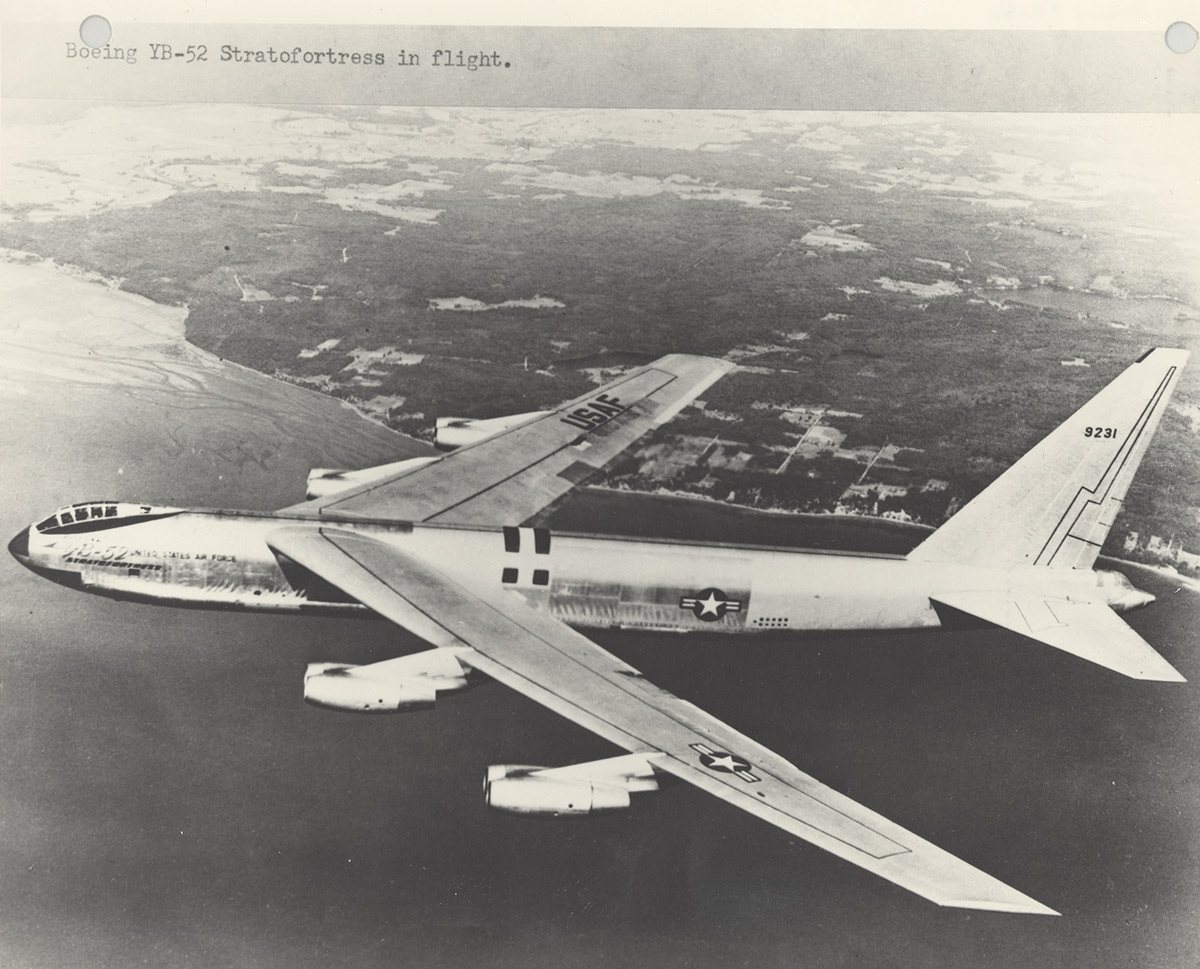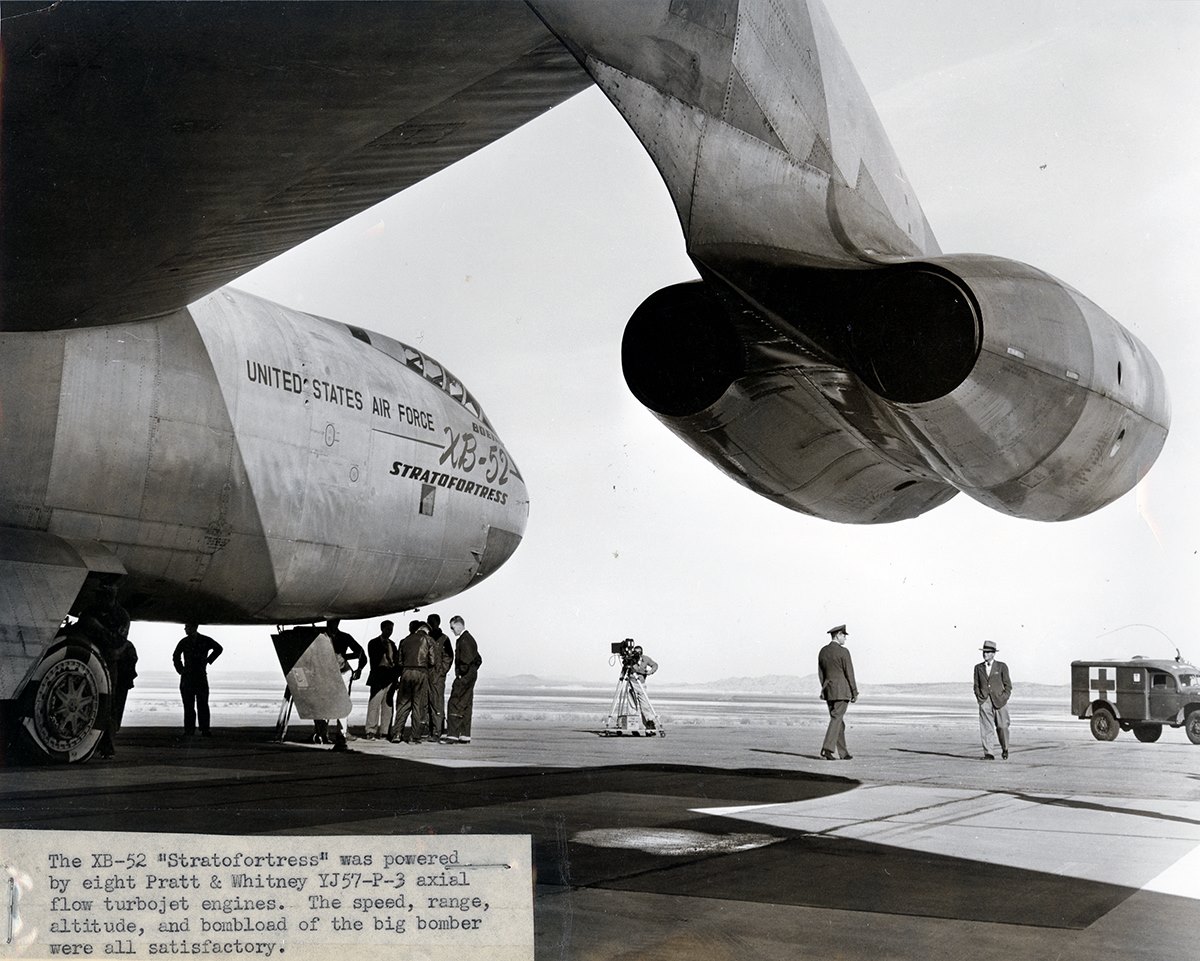The designations XB-52 and YB-52 were assigned to these prototype B-52 aircraft. X stands for “experimental,” and Y stands for “prototype.”
The B-52 was the primary long-range heavy bomber of the US Air Force during the Cold War after it went into service in 1955, and it is still a crucial component of the USAF bomber force today.
In his book Boeing B-47 Stratojet & B-52 Stratofortress Origins and Evolution, Scott Lowther explains how the Model 464-49, which was chosen as the XB-52’s winning design, evolved into the Model 464-67. Although they were similar in many ways, there were several noticeable variations, most notably the enlargement of the forward Fuselage. 464-67 had the cockpit well in front of the wing, as opposed to 464-49 which had the cockpit canopy’s rear behind the leading edge of the wing roots. The engine nacelles were modified, and the spoilers on the wings’ comparatively large area were shrunk. With these modifications, Boeing was prepared to start building two Model 464-67s after receiving an Air Force “letter of intent” for B-52 tooling in March 1951.

The designations XB-52 and YB-52 were assigned to these prototype B-52 aircraft. X stands for “experimental,” and Y stands for “prototype.” Usually, an “experimental” aircraft is constructed before a “prototype,” but in this instance, the YB-52 took flight first on April 15, 1952, while the XB-52 (serial number 49-230) rolled out on November 29, 1951, and the YB-52 (serial number 49-231) followed on March 15, 1952. This was because the XB-52 needed major repairs after damage occurred during testing of the pneumatic system’s pressurization.
On October 2, 1952, the XB-52 took to the skies after the prototype. The YB-52’s two-hour initial flight was powered by YJ57-P-3 prototype engines. The XB-52 and YB-52 were basically the same despite having different names.
In terms of appearance, the prototype B-52s and the finished aircraft shared many similarities. The cockpit, however, was a feature that stood out between the two planes right away. The pilot had good visibility thanks to the low-drag tandem fighter-style canopy, which was used on the B-47.

The layout of the landing gear used by the rest of the B-52 fleet was pioneered by the prototypes. Though at first appearing to be fairly comparable to the B-47’s bicycle arrangement, the B-52’s gear was very different. Four separate dual-wheel bogies were stored within the B-52 fuselage, but instead of deploying straight down, they deployed out to the sides, twisting around so that the bogies stored fore-and-aft ended up side-by-side. This gave the B-52 not a bicycle arrangement, but a quadricycle.
The main landing gear of the B-52 would allow it to sit levelly without leaning to one side or the other. It continued to use smaller outrigger gear close to the wingtips, although this was done to prevent wingtip impact with the ground during heavy takeoffs or bumpy landings.
Moreover, the B-52 was able to land while “crabbing” into the wind with its fuselage oriented significantly off the plane’s groundpath because to its forward bogies’ ability to swivel up to 20° side to side. This would allow for risk-free landings in strong winds.
The main wings of the prototypes had flapperons, ailerons, and spoilers. The inboard engine pylon was right outside the ailerons, which were small and placed far from the wingtip. The ailerons would have had better control if they had been positioned at the wingtip, but that would have placed them in a much thinner and more flexible area of the wing. The inboard spot was suitable for the maneuvers the bomber was supposed to make.

In any case, the spoilers were to handle the majority of the aircraft’s control requirements, making the ailerons redundant over time. The prototypes lacked the capacity to refuel in flight, unlike the subsequent production aircraft. The external fuel tanks that often adorned the outer wings of B-52 production models were also absent at first, but they were finally fitted later in the testing phase.
All of the horizontal stabilizers could move, although this movement was intended to stabilize the trim. Real control was carried out via small elevators around the back. Trim tabs were present in the elevators of the B-52F. The folding vertical fin was a significant but underappreciated characteristic of all B-52s that came after the prototype. Up until the G-model, the fin was a sizable structure that was far too tall to allow the B-52 to fit inside conventional hangars.
As a result, it could fold over 90 degrees, significantly decreasing the aircraft’s effective height. The fielding fin is not a self-contained system; an additional crane is required to lay it over and hoist it back up again, in contrast to naval aircraft that have wings that can fold to fit in the constrained area on board aircraft carriers.
The Boeing Seattle factory essentially handcrafted the prototypes. Jigs were not finalized, therefore production processes were not applied, and frequently, standard instruments and equipment were not used. The tail turrets on either prototype were represented by static fairings with painted-on lines; none was equipped with defensive armaments.
After 783 hours of flight, the YB-52 was handed to the US Air Force Museum on January 27, 1958. It was on display for a while, but the XB-52 and YB-52 were both scrapped sometime in the 1960s as a result of a “beautification” plan coordinated by First Lady Lady Bird Johnson. The available literature does not sufficiently explain how the official museum of the United States Air Force was ‘beautified’ by turning one of the most beautiful airplanes ever made into razor blades and soda cans.
Boeing B-47 Stratojet & B-52 Stratofortress Origins and Evolution is published by Mortons Books and is available to order here.
Photo by: U.S. Air Force

